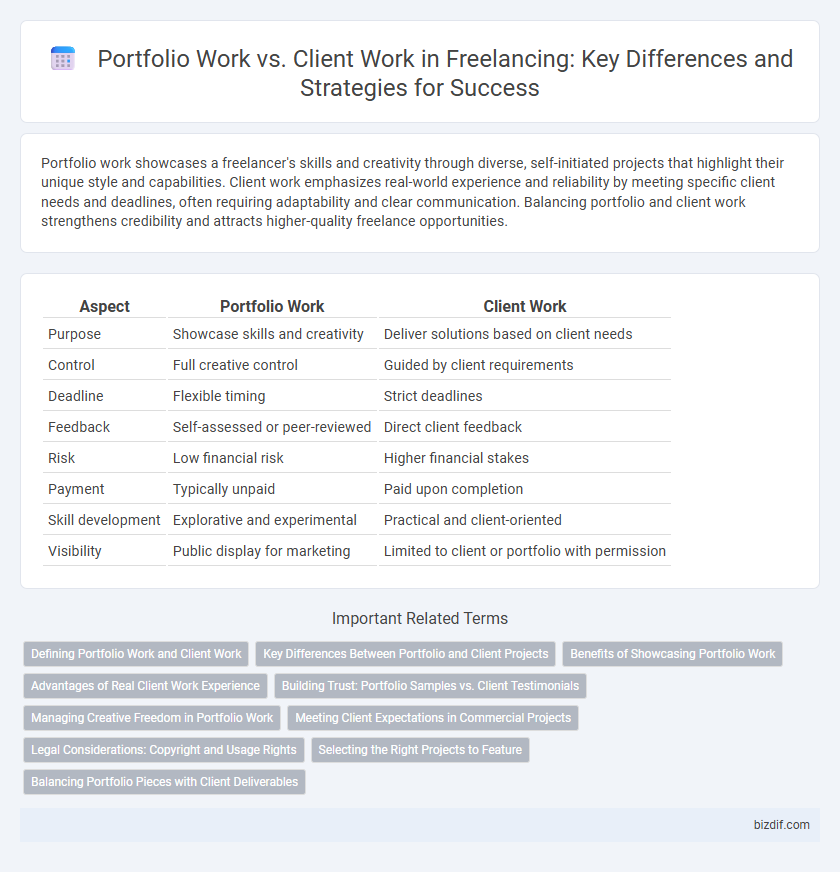Portfolio work showcases a freelancer's skills and creativity through diverse, self-initiated projects that highlight their unique style and capabilities. Client work emphasizes real-world experience and reliability by meeting specific client needs and deadlines, often requiring adaptability and clear communication. Balancing portfolio and client work strengthens credibility and attracts higher-quality freelance opportunities.
Table of Comparison
| Aspect | Portfolio Work | Client Work |
|---|---|---|
| Purpose | Showcase skills and creativity | Deliver solutions based on client needs |
| Control | Full creative control | Guided by client requirements |
| Deadline | Flexible timing | Strict deadlines |
| Feedback | Self-assessed or peer-reviewed | Direct client feedback |
| Risk | Low financial risk | Higher financial stakes |
| Payment | Typically unpaid | Paid upon completion |
| Skill development | Explorative and experimental | Practical and client-oriented |
| Visibility | Public display for marketing | Limited to client or portfolio with permission |
Defining Portfolio Work and Client Work
Portfolio work consists of projects created independently or speculatively to showcase skills, creativity, and expertise, often demonstrating a freelancer's versatility and style for potential clients. Client work involves tasks completed based on specific requirements provided by clients, emphasizing meeting deadlines, budgets, and clear communication to deliver tailored solutions. Defining portfolio work helps freelancers market their capabilities, while client work builds professional relationships and generates income.
Key Differences Between Portfolio and Client Projects
Portfolio projects showcase a freelancer's skills, creativity, and range through self-initiated or speculative work designed to attract clients, while client projects are completed based on specific client requirements and contracts. Portfolio work allows more creative freedom and experimentation without strict deadlines, whereas client projects demand adherence to agreed timelines, budgets, and deliverables. The primary distinction lies in ownership and purpose: portfolio pieces highlight talent for marketing, whereas client projects focus on fulfilling real-world business needs and generating income.
Benefits of Showcasing Portfolio Work
Showcasing portfolio work highlights a freelancer's skills, creativity, and versatility, making it easier for potential clients to assess quality and fit. A well-curated portfolio builds credibility and establishes trust by demonstrating completed projects across various industries and styles. Unlike client work, portfolio pieces can be strategically selected and presented to target specific markets or niches, enhancing marketing effectiveness.
Advantages of Real Client Work Experience
Real client work experience provides freelancers with authentic project challenges and dynamic problem-solving opportunities that build practical skills and industry relevance. It enhances credibility and trustworthiness by showcasing actual results and client testimonials, making portfolios more persuasive to future clients. Exposure to diverse client needs also improves adaptability and communication, critical factors for long-term freelancing success.
Building Trust: Portfolio Samples vs. Client Testimonials
Portfolio samples showcase a freelancer's skills and style through tangible projects, helping potential clients visualize the quality of work offered. Client testimonials provide social proof by sharing real experiences and satisfaction, establishing credibility and trustworthiness. Combining diverse portfolio pieces with strong client reviews maximizes the freelancer's ability to gain confidence and secure new contracts.
Managing Creative Freedom in Portfolio Work
Balancing creative freedom in portfolio work allows freelancers to showcase innovative skills and unique styles that attract prospective clients. Unlike client work, which often has strict guidelines and expectations, portfolio projects provide a platform to experiment and push boundaries, enhancing personal brand value. Effective management of this freedom involves setting clear goals and maintaining quality standards to ensure the work resonates with the freelancer's target market.
Meeting Client Expectations in Commercial Projects
Meeting client expectations in commercial projects requires balancing portfolio work with timely, high-quality deliverables that align with the client's brand and objectives. Effective communication and a deep understanding of project requirements ensure the freelancer delivers results that enhance client satisfaction and long-term partnerships. Prioritizing client feedback and refining work based on real-world commercial needs strengthens trust and drives project success.
Legal Considerations: Copyright and Usage Rights
Portfolio work and client work involve distinct legal considerations regarding copyright and usage rights, as freelancers must ensure explicit agreements define ownership and permissible use of deliverables. Copyright typically remains with the freelancer unless a work-for-hire clause transfers rights to the client, making clear contracts essential to avoid disputes. Proper documentation of usage rights in client projects protects both parties and clarifies the scope of usage for marketing or portfolio presentation.
Selecting the Right Projects to Feature
Selecting the right projects to feature in a freelancing portfolio involves showcasing diverse skills and notable client results that align with target market demands. Highlighting client work with measurable outcomes, such as increased conversions or successful campaigns, builds credibility and trust with prospective clients. Balancing personal portfolio pieces that demonstrate creativity and technical expertise alongside client projects ensures a comprehensive representation of a freelancer's capabilities.
Balancing Portfolio Pieces with Client Deliverables
Balancing portfolio pieces with client deliverables requires strategic time allocation to showcase diverse skills while meeting client deadlines. High-quality portfolio work demonstrates expertise and attracts future clients, whereas client projects build reputation and generate income. Prioritizing tasks and integrating client successes into the portfolio enhances credibility and marketability in freelancing.
portfolio work vs client work Infographic

 bizdif.com
bizdif.com